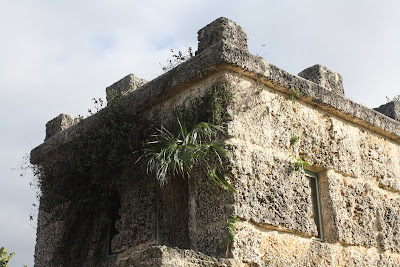Here is David at the entrance to Edward Leedshalnin's living quarters located on the top floor of the tiny cube of a building. His workshop was located on the bottom floor.
 Ed built this gated park all by himself. He was 5 ft tall and weighed 100 lbs. He worked alone and it took him 20 years to build. Using only hand tools he cut, carved, and moved huge pieces of coral. This rock is found throughout Florida sometimes just inches below the soil surface.
Ed built this gated park all by himself. He was 5 ft tall and weighed 100 lbs. He worked alone and it took him 20 years to build. Using only hand tools he cut, carved, and moved huge pieces of coral. This rock is found throughout Florida sometimes just inches below the soil surface.  Here is the gang standing in front of a traveling palm tree. Isn't it the neatest thing you ever saw. We were all very impressed with this little Coral Castle (Rock Gate Park).
Here is the gang standing in front of a traveling palm tree. Isn't it the neatest thing you ever saw. We were all very impressed with this little Coral Castle (Rock Gate Park). This is Ed's Bar-B-Que he built in the 1930's The fire was built in the hole in the bottom. The cooking pot is the rear end housing of an old Ford. It hangs on pulleys riding on a rail. The food is placed in the container, which seals itself.
This is Ed's Bar-B-Que he built in the 1930's The fire was built in the hole in the bottom. The cooking pot is the rear end housing of an old Ford. It hangs on pulleys riding on a rail. The food is placed in the container, which seals itself.  Feast of Love Table. It is perfectly heart shaped with a heart in the center. He could not provide fresh flowers daily so he planted this Ixora plant. It is Ed's original plant. It has been in place 40-50 years. The table weighs 5,000 pounds. They have at least one wedding there on Valentines Days and this table is in Ripley's Believe It Or Not.
Feast of Love Table. It is perfectly heart shaped with a heart in the center. He could not provide fresh flowers daily so he planted this Ixora plant. It is Ed's original plant. It has been in place 40-50 years. The table weighs 5,000 pounds. They have at least one wedding there on Valentines Days and this table is in Ripley's Believe It Or Not. 
Go to part 2











































